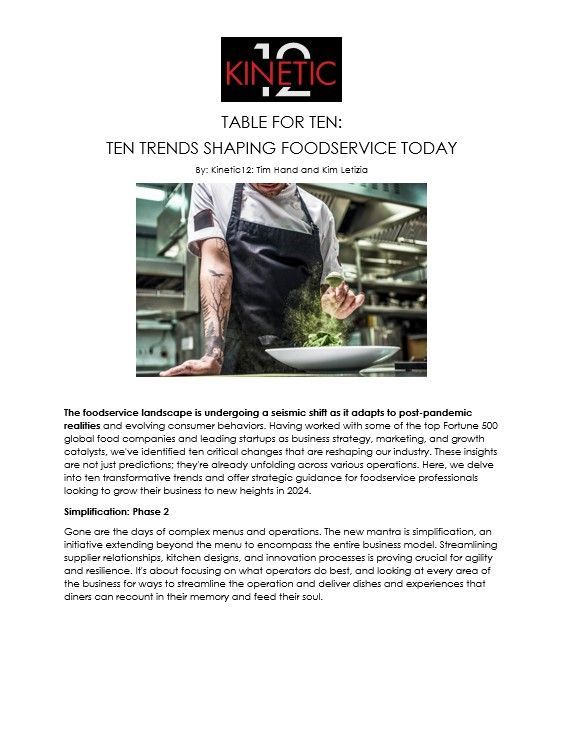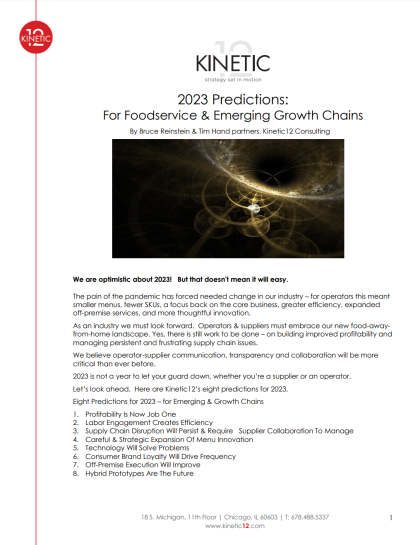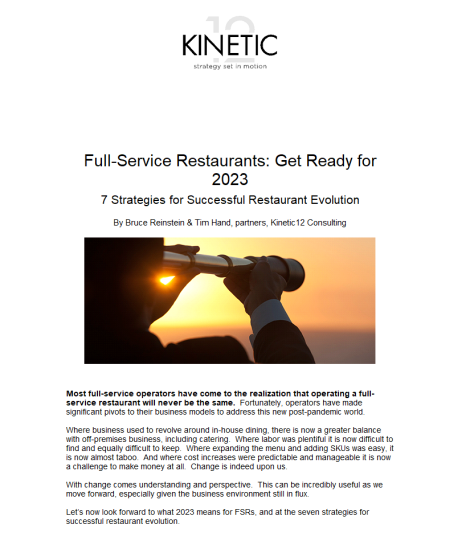Four Key Collaboration Learnings to Navigate 2025
The food industry stands at a crossroads as we near the end of Q1 2025. The landscape is shifting fast, and uncertainty has become a common feeling for industry leaders. Consumers, battered by inflation, are making tough choices, reshaping dining habits, and forcing the industry to rethink its strategies.
Simultaneously, operators, manufacturers, and distributors are struggling to drive growth as sales slow due to declining foot traffic. This has led many to actively prioritize new streams of revenue to offset those challenges, underscoring the growing urgency to diversify revenue sources.
Adding to these pressures, industry leaders are facing other disruptions, including tariffs and regulatory shifts, making it more challenging to hit the sweet spot between innovation, growth, and profitability.
In this time of uncertainty and change, collaboration isn’t just a safeguard—it’s the launchpad for innovation, growth, and industry leadership. The strongest companies won’t wait for stability; they’ll create it through strategic partnerships. The data is clear: companies that fail to build strong partnerships will fall behind. By building deep, meaningful partnerships with suppliers and customers, foodservice businesses won’t just weather the storm—they’ll lead the charge into a stronger, more resilient future. Industry leaders consistently highlight strategic collaboration as a crucial driver of revenue growth, reinforcing the importance of strong partnerships.
With years of experience leading collaborative initiatives across foodservice—ranging from working with distributors to develop truly collaborative category planning processes to leading an industry-wide initiative focused on optimizing the foodservice supply chain to launching a program on Collaborative Innovation that is now entering its seventh year—the partners of Kinetic12 have seen firsthand what drives successful partnerships. Based on these experiences, here are four essential collaboration learnings for 2025:
1. A Cross-Functional Approach Outperforms a Single Point of Contact
Historically, many industry relationships have relied on one-to-one connections, such as operator procurement dealing solely with manufacturer sales or distributor category managers engaging only with manufacturer sales teams. This siloed approach creates risks—particularly when a single gatekeeper slows progress or leaves the business due to turnover. Unfortunately, in today’s age, the one-on-one approach does not deliver the speed, efficiency, and depth of collaboration that modern foodservice demands.
Instead, adopting a “many-to-many” model can enhance the relationship dynamic. The primary point of contact should act as a
relationship director, ensuring that culinary teams, supply chain teams, and marketing teams from both organizations are directly engaged with their counterparts. This approach accelerates decision-making, enhances communication, and leads to stronger, more resilient partnerships.
2. Collaboration Must Begin with Shared Insights
No single company has all the answers—true collaboration stems from sharing data and insights to develop mutually beneficial strategies.
For example, a national chain operator may possess deep insights into their customer behavior, while a manufacturer might have detailed category-specific data on a particular menu item. By combining these data sets, both parties can identify three to four actionable growth opportunities that would have been impossible to uncover in isolation. Operators increasingly recognize the importance of data-driven insights in driving menu optimization and staying competitive.
With the increasing availability of advanced analytics and AI-driven tools, strategic collaboration centered on shared insights will only become more valuable in 2025. Companies that effectively leverage shared data are seeing significant improvements in menu innovation success rates, highlighting the tangible benefits of collaboration.
3. Formalize Agreements and Follow Through
One of the biggest pitfalls in collaboration is the failure to execute on agreed-upon initiatives. Too often, trading partners leave meetings feeling accomplished, only to realize months later that no action has been taken.
To combat this, partners must do more than just talk. They must
document, commit, and execute. A handshake isn’t enough—results come from clear accountability and relentless follow-through. The “relationship director” (as outlined in Learning #1) plays a crucial role in ensuring execution, but all parties need to align on key metrics, objectives, timelines, and next steps for each individual for the team to stay accountable to each other and the project at hand. Digital tools such as project management platforms (PMOs) and customer relationship management (CRM) systems make it easier to track progress, but success ultimately depends on both parties prioritizing follow-through alongside day-to-day operations. Teams that implement structured collaboration frameworks are more likely to meet their joint business objectives, demonstrating the power of a disciplined approach.
4. Shift the Focus from Problems to Opportunities
Too many trading partners waste valuable time firefighting, reacting instead of strategizing. The best companies refuse to be caught in a cycle of problem-solving—they dedicate time to proactive opportunity discussions that drive growth. However, highly collaborative companies balance problem-solving with proactive opportunity discussions.
Leading organizations dedicate time in each conversation to exploring market trends, sharing relevant research, and identifying potential growth areas. Foodservice leaders acknowledge that supplier collaboration on emerging trends is a key factor in staying competitive in an evolving market. Even small, forward-thinking discussions can strengthen relationships and unlock new revenue streams. This doesn’t mean ignoring challenges, but rather ensuring that
opportunities remain a core component of collaboration.
Final Thoughts
As we continue navigating 2025, these four collaboration principles can help industry leaders strengthen their most valuable relationships. As we highlighted in our November article,
Growing In A Flat Market: A Manufacturer's Dilemma, maintaining and growing existing partnerships is far more efficient than building new ones from scratch. By embracing
cross-functional engagement, shared insights, structured follow-through, and an opportunity-first mindset, foodservice companies can seize the moment and make 2025 not just about surviving—but thriving.
About Kinetic12: Art Bell & Kim Letizia are with Kinetic12 Consulting, a Chicago-based Foodservice and general management consulting firm. The firm works with leading Foodservice suppliers, operators, and organizations on customized strategic initiatives, as well as guiding multiple collaborative forums and best practice projects. They also engage as keynote speakers at operator franchise conferences and supplier sales meetings. Their previous leadership roles in restaurant chain operations and at foodservice manufacturers provide a balanced industry perspective.
Contact us to learn more about how we can help your organization through customized consulting or through participating in our Emerging & Growth Chains program.



